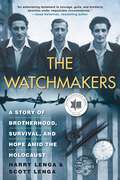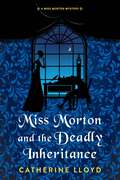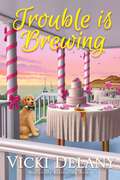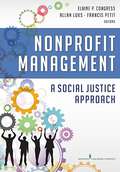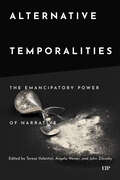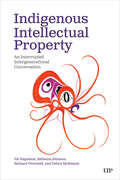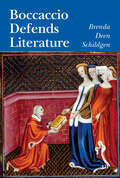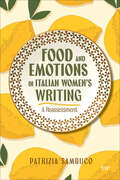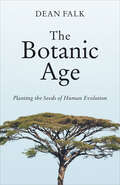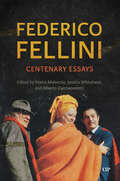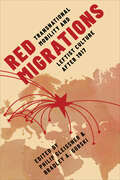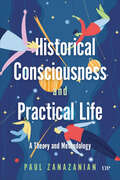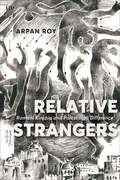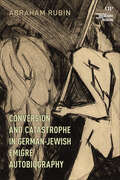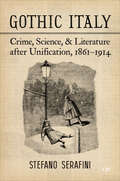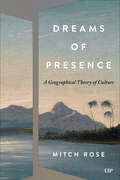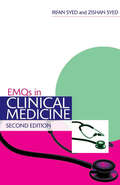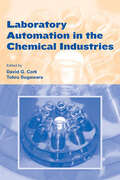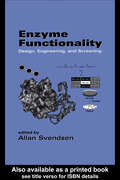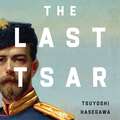- Table View
- List View
i-Ready Classroom: Mathematics, Grade 4, Fluency and Skills Practice
by Curriculum Associates Llc.NIMAC-sourced textbook
Ciencias para Texas, Grado 1
by Douglas Fisher Jay K. Hackett Julie K. JacksonNIMAC-sourced textbook
Amplify Science: California Student Edition, Grade 7, Integrated
by Amplify EducationNIMAC-sourced textbook
The Watchmakers: A Powerful WW2 Story of Brotherhood, Survival, and Hope Amid the Holocaust
by Harry Lenga Scott Lenga2022 National Jewish Book Award Finalist&“Inspiring. Exhilarating. Astonishing. An epic tale of brotherhood, ingenuity, and survival.&” —Heather Dune Macadam, International Bestselling author of 999: The Extraordinary Young Women of the First Official Jewish Transport to AuschwitzTold through meticulous interviews with his son, this is an extraordinary memoir of endurance, faith, and a unique skill that kept three brothers together—and alive—during the darkest times of World War II.&“A truly extraordinary book.&” —Damien Lewis, #1 international bestselling author Harry Lenga was born to a family of Chassidic Jews in Kozhnitz, Poland. The proud sons of a watchmaker, Harry and his two brothers, Mailekh and Moishe, studied their father&’s trade at a young age. Upon the German invasion of Poland, when the Lenga family was upended, Harry and his brothers never anticipated that the tools acquired from their father would be the key to their survival. Under the most devastating conditions imaginable—with death always imminent—fixing watches for the Germans in the ghettos and brutal slave labor camps of occupied Poland and Austria bought their lives over and over again. From Wolanow and Starachowice to Auschwitz and Ebensee, Harry, Mailekh, and Moishe endured, bartered, worked, prayed, and lived to see liberation. Derived from more than a decade of interviews with Harry Lenga, conducted by his own son Scott and others, The Watchmakers is Harry&’s heartening and unflinchingly honest first-person account of his childhood, the lessons learned from his own father, his harrowing tribulations, and his inspiring life before, during, and after the war. It is a singular and vital story, told from one generation to the next—and a profoundly moving tribute to brotherhood, fatherhood, family, and faith.&“Deeply moving.&” —Jesse Kellerman, bestselling author&“Vivid and compelling.&” —Christopher R. Browning, Frank Porter Graham Professor of History Emeritus, University of North Carolina at Chapel Hill, and author of Ordinary Men
Miss Morton and the Deadly Inheritance (A Miss Morton Mystery #3)
by Catherine LloydSocial standing is everything in Regency England—and no one knows better than Miss Caroline Morton, a lady&’s companion from a disgraced line. But when she has a chance to claim what&’s rightfully hers, the one obstacle in her way is a dangerous murder mystery . . . Miss Caroline has doubts when she receives an urgent invitation from a London law firm to discuss her late father&’s estate. After all, the dishonored Earl of Morton died without a pound sterling to pass on to his two daughters. But while immersing herself in helping Mrs. Frogerton&’s capricious daughter navigate the high social season, Caroline meets with a cagey lawyer, Mr. Smith, who shares life-altering news—the earl composed a second will, leaving behind an undisclosed fortune. Mrs. Frogerton, however, is thoroughly unimpressed with the firm&’s conduct and suspicious of their true motives. Her instinct proves right when the two ladies find the office ransacked, staff in turmoil, and Mr. Smith missing. The full weight of the situation doesn&’t sink in until Mr. Smith dies following a brutal attack on the street—discovered with an empty envelope bearing Caroline&’s name in his pocket. With a connection forming between two deaths at the firm, Caroline can&’t imagine why anyone would kill twice over the contents of a will. Further complicating matters is the amorous Mr. DeBloom—who claims his mother goaded the earl into making bad investments and promises to link Caroline to her inheritance—and the disappearance of Susan, her younger sister. As Caroline unwittingly becomes the center of both a criminal case and a sordid love triangle, she must tread with caution while seeking the truth . . . because someone is waiting to reduce her to nothing more than a signature on a dotted line.
Trouble Is Brewing (Tea by the Sea Mysteries #5)
by Vicki DelanyLily Roberts&’s Cape Cod tearoom is hosting a bridal shower—until a gruesome gift sends the guest of honor running in fear . . . Members of the Reynolds and Hill families are staying at Lily&’s grandmother&’s bed and breakfast, and now they&’ve gathered at Tea by the Sea to sip some delicious blends while they shower bride-to-be Hannah Hill with presents. But the last package Hannah unwraps contains a beheaded Raggedy Ann doll and triggers a bloodcurdling scream. A doll like this was the last gift from her father before he died long ago, and she&’s chilled to the bone. Lily senses that the shocking anonymous gift just might be related to other tensions she&’s picking up on. The mothers-in-law have been sniping at each other—and then Lily, out walking her dog, overhears the groom&’s father, Ralph, offering his son a very sizable bribe to call off the wedding. She&’s relieved when Greg angrily turns him down, but with so many people steamed at each other, can this event possibly go smoothly? The answer is no. It suddenly has to be postponed—when Ralph is found dead in his bed, a bottle of whiskey beside him. When tests indicate the booze was infused with a lethal substance, it becomes a murder case, and of course, accusations are flying wildly with the guests all too willing to believe the worst about each other. Now, to find out whether all this family drama led to a fatality, Lily will have to turn up the heat . . .
Livestock Handling and Transport
by Temple GrandinEdited by world-renowned animal scientist Dr Temple Grandin, this book integrates scientific research and industry literature on cattle, pigs, poultry, sheep, goats, deer, and horses, in both the developed and developing world, to provide a practical guide to humane handling and minimizing animal stress. Reviewing the latest research on transport systems, restraint methods and facilities for farms and slaughterhouses, this new edition expands on new developments in the field, as well as covering the integration of and potential welfare benefits and costs of technological advances such as virtual fencing. An important read for animal scientists, animal welfare researchers and practitioners, and veterinarians, this straightforward text is also a valuable resource for stock-people and farmers.
Nonprofit Management: A Social Justice Approach
by Elaine P. Congress Allan Luks and Francis PetitNonprofit organizations are increasingly concerned with the need to demonstrate how social justice principles impact every aspect of their work. This is the only textbook to explicitly integrate social justice principles into the management of a nonprofit organization. It provides students with the knowledge and skills required to integrate a social justice value system into their work as effective nonprofit leaders. Using practical tips and illustrative case examples, the text explains the structure and processes of nonprofit organizations with a particular emphasis on social justice themes. Nonprofit Management: A Social Justice Approach is edited by an interdisciplinary team of prominent leaders in business, management, and social service, who together run the Fordham Center for Nonprofit Leaders. They have assembled a group of expert authors who provide extensive coverage of the nonprofit leadership field. The book discusses the history of the development of nonprofit management up to the present day. It addresses legal and ethical considerations, organizational planning and staff management, finance, public relations, fundraising, public advocacy and volunteerism, program design and grant development, governance and board development, developing an international nonprofit, information technology, career development, and creating a nonprofit/social entrepreneurship organization. Additional chapters address quality improvement, mentoring, and proposal writing. The text is ideal for students and faculty in social service administration, human service leadership, social work management, public and community health, public administration, and health care administration and management.
Alternative Temporalities: The Emancipatory Power of Narrative
by John Zilcosky Teresa Valentini Angela WeiserAlternative temporalities have often emerged as a reaction to the normativizing force of time, demonstrating that time can be used as an instrument of power and oppression, but also as a means to resist this very oppression. Alternative Temporalities draws on analyses of modern literature to examine this often-neglected role of time. By exploring forms of temporal resistance in artistic representation, such as short stories and novels, that challenge the imposition of colonial, gender, or capitalist temporal orders, the book reveals how storytelling can be an essential tool in questioning and pushing back against coercive temporal structures. The book analyses literary representations of time that challenge dominant temporalities and intersect different disciplines such as gender and sexuality studies, trauma and Indigenous studies, race and identity, and religion. It features narrative analyses proposing alternative embodied experiences of time, focusing on topics including the temporality of the AIDS-affected body, the experience of time in prison, and slowness in opposition to modern acceleration. Ultimately, Alternative Temporalities aims to create new theories as well as practices that may foster more diverse and inclusive ways of perceiving and embodying time.
Indigenous Intellectual Property: An Interrupted Intergenerational Conversation
by Val Napoleon, Rebecca Johnson, Richard Overstall, and Debra McKenzieHistorically, Indigenous artistic, cultural, and societal expression has been identified and examined within Canadian or international legal regimes. This book identifies Indigenous intellectual property concerns as an Indigenous legal issue to be taken seriously within specific Indigenous legal orders. Indigenous Intellectual Property opens up complex discussions about existing Indigenous intellectual property law, and avoids the tendency to pigeonhole Indigenous intellectual property into a Western legal model. Drawing on diverse case studies, this book considers the existing laws in the Gitxsan, Secwepemc, and Hupacasath (Nuu-chah-nulth) legal orders, as well as from the Solomon Islands and Hawai’i. The case studies are grounded in their respective legal and oral histories, and contextualized within a broader discussion of Indigenous law, addressing issues of colonial myths, shrinking conceptions of Indigenous law, common resistances to Indigenous property and law, and important connections between Indigenous law and governance and citizenship. The book carefully considers how the governance and civic value of intellectual property points to the unsuitability of the current state and international intellectual property legal regimes to many Indigenous intellectual property concerns. Ultimately, Indigenous Intellectual Property reveals the various ways in which to identify and understand law within Indigenous societies – through narrative and story analysis, observations of practices and ceremonies, and political and legal ordering.
Boccaccio Defends Literature
by Brenda Deen SchildgenIn Boccaccio Defends Literature, Brenda Deen Schildgen contends that Giovanni Boccaccio’s significant contribution to literary history remains underappreciated. The book asserts that Boccaccio refuted the detractors that condemned poetry as immoral, irrational, and even demonic, highlighting instead its aesthetic and cathartic ability to restore equilibrium, provoke thought, and provide solace and entertainment. The book explores how, despite often being dismissed for his morally dubious tales, Boccaccio dedicated himself to defending the legacy of the ancients, endorsing vernacular and secular literature, and cementing the reputations of Dante and Petrarch. It reveals how he forged a wholly new direction for literary prose fiction, driven by his commitment to humanistic studies and admiration for literary achievement. Without moral or spiritual hesitation, Boccaccio asserted that literature – whether pagan or Christian – was an autonomous form of knowledge, a stance he maintained from the 1350s to the end of his life. Contesting the arguments of moralists who sought to ban books, Schildgen demonstrates that Boccaccio advocated for the independence of readers, asserting that they, not writers, bore the responsibility for their responses to literature. Boccaccio Defends Literature thus unveils Boccaccio as a steadfast defender of the enduring relevance of literature.
Food and Emotions in Italian Women's Writing: A Reassessment (Toronto Italian Studies)
by Patrizia SambucoFood and Emotions in Italian Women’s Writing discusses the relevance of food imagery in the writing of Italian women over a period of one hundred years, from the 1920s to the present day, while offering new ways to narrate women’s history and creativity. In this groundbreaking work, Patrizia Sambuco shows how food imagery in different historical periods challenge established political discourses by conveying unexpressed, alternative, or transgressive emotions. Through literary analysis, archival research, and philosophical approaches to the senses, emotions, and food, the book considers a variety of authors, from the celebrated to the hardly known. Sambuco argues that in different ways, throughout the decades, the conceptual domain of food has helped express forms of selfhood that push the boundaries of womanhood and interact with cultural and political panoramas at national and international levels. Building an alternative history of Italian women and their creativity, Sambuco shows how the interplay of the senses and emotions becomes a profitable way to illuminate overlooked aspects of women’s subjectivity. Food and Emotions in Italian Women's Writing ultimately reassesses women’s writing, giving value to the marginality of women’s bodies and positions through the conceptual domain of food.
The Botanic Age: Planting the Seeds of Human Evolution
by Dean FalkHow and why did humans get to be so clever and thoughtful? The beginning of the Stone Age, marked by the invention of stone tools, has traditionally dominated discussions about the origin and evolution of human intelligence. However, feminist anthropologists have long theorized that the first tools were actually nests, slings, and baskets that would not have survived in the archaeological record. In The Botanic Age, leading evolutionary anthropologist Dean Falk argues that millions of years of weaving botanical materials and woodworking preceded the Stone Age, facilitating the basic neurological underpinnings for humankind’s later creative and technological inventions. She further suggests that mothers and infants may hold the key to understanding a series of events that eventually kindled the emergence of advanced cognitive abilities, including language and music. The Botanic Age takes readers millions of years into the past to a time before our relatives began living full-time on the ground. From stationary hominin sleeping trees in Africa to beached trees on the shores of Indonesia, the impact of the Botanic Age on hominin evolution was far-reaching. Only from this vantage point “in the trees” can we really begin to understand how and why our ancestors evolved – and how we became human.
Federico Fellini: Centenary Essays (Toronto Italian Studies)
by Marco Malvestio Jessica Whitehead Alberto ZambenedettiA complex and at times controversial film-maker whose career spanned the second half of the twentieth century, Federico Fellini (1920–1993) remains central to the Italian cultural imagery and the object of ongoing debates and critical scrutiny at home and abroad. Images from his films – Gelsomina’s tears, Marcello’s sunglasses – have become global signifiers not only for Fellini and Italian cinema but for Italy itself, as steadily lodged in the world’s collective unconscious as the Colosseum’s arches and Venice’s gondolas. Marking the centenary of Fellini’s birth, Federico Fellini: Centenary Essays reassesses the film-maker’s legacy with diverse contributions from established and emerging Fellini scholars as well as renowned Canadian film-makers. From literary influences to pictorial references, from artistic collaborations to politics, and from exhibition history to revivals, the collection covers the pivotal aspects of Fellini’s poetics through contemporary methodological tools and features a wide array of scholarly approaches. With complexity and nuance, the book takes stock of the enormous cultural legacy of one of the most celebrated directors in cinema history and is essential reading for scholars and cinephiles alike.
Truth Is Trickiest: The Case for Ambiguity in the Exeter Book Riddles
by Jennifer NevilleAt the end of the tenth-century English manuscript the Exeter Book, there is a collection of almost one hundred riddles. They are notable for many reasons, but one feature in particular has challenged modern readers: their lack of solutions. In Truth Is Trickiest, Jennifer Neville argues that the absence of solutions, rather than being an unfortunate accident, uncovers an essential quality of these texts. In opposition to the general expectation that a successfully solved riddle will have one correct answer, Neville argues that the Exeter Book riddles are written to generate multiple solutions. The correct response to an Exeter Book riddle is not a single, elegant solution but instead an ongoing process of interpretation that leads readers to question what they think they know. Truth Is Trickiest contextualizes its readings within the larger field of Old English poetry, early medieval material culture, and Anglo-Latin riddles. The book pursues the central issue of interpretation in relation to social values, craftsmanship, hierarchical social structures, violence, irony, humour, and sexuality. It concludes with a full list of previously proposed solutions to document the history of the ongoing argument that the Exeter Book riddles have provoked.
Red Migrations: Transnational Mobility and Leftist Culture after 1917
by Philip Gleissner Bradley A. GorskiTogether with a new political, social, and cultural order, the Bolshevik Revolution also brought about a spatial revolution. Changed patterns, motivations, and impacts of migration collided with new cultural forms and aesthetic mandates. Red Migrations highlights the various multidirectional and multilateral transnational movements of leftist thinkers, artists, and writers. The book draws on avant-garde poets such as David Burliuk, Marxist theoreticians such as János Mácza, and “fellow travellers” such as Langston Hughes, revealing how leftists of all stripes were inspired and at times impelled by the Soviet Revolution to cross borders. It explores how the resulting circulation of ideas, aesthetic forms, and individuals not only contributed enormously to the ferment of creative activity in the early Soviet years, but also deeply informed international leftist aesthetics and political practice throughout the twentieth century. The robust and diverse transnational networks created by these circulations are at the centre of this volume. With original archival research and insightful analyses, Red Migrations sheds light on the ideals, aspirations, and disappointments of leftist transnationalism from the 1920s through the 1960s and the aesthetic forms they engendered.
Historical Consciousness and Practical Life: A Theory and Methodology
by Paul ZanazanianHistorical Consciousness and Practical Life introduces a novel approach to examining how people construct and employ historical knowledge in their daily lives. In viewing history as an embodied cultural practice that constitutes the background to our meaning-making, the book demonstrates how researchers and others can investigate the ways in which people make sense of time’s flow in their now-moment engagements with the world and use that information to position themselves regarding key social problems with historical roots. The book provides a glimpse at how humans enter historically embedded thinking problems, seeking to resolve them. Paul Zanazanian draws on a study of the community leaders of English-speaking Quebec to illustrate the practical life methodology’s workings. In looking at their different uses of history for strengthening their group’s vitality in the province, he identifies five key stances these leaders employ for positioning their sense of purpose and responsibility for securing English-speaking Quebec’s future. Ultimately, Historical Consciousness and Practical Life argues that community leaders who complicate and problematize their uses of history are the best positioned to make positive transformations for their group.
Relative Strangers: Romani Kinship and Palestinian Difference (Anthropological Horizons)
by Arpan RoyExamining how memory, intergenerational transmission, and kinship work together, Relative Strangers sheds light on Romani life in Palestine. Arpan Roy presents an ethnographic portrait of Dom Romani communities living between Palestine and Jordan, zooming in on everyday life in working-class neighborhoods, and under conditions of perpetual war and instability. The book focuses on how Doms are able to sustain ethnic difference through kinship, even when public performances of difference are no longer emphasized – a kind of alterity that is neither visible by obvious markers like race or religious difference, nor detected by the antennas of the state. Drawing on long-term ethnographic fieldwork in Jerusalem, Ramallah, and Amman, Roy makes a case for such alterity for Romani people and other groups in the region. Analysing intimate ethnographic scenes through anthropological theories of kinship, psychoanalysis, social theory from the Global South, and more, the book reveals how alterity in the Middle East does not adhere to rigid identitarian categories. Ultimately, Relative Strangers demonstrates the inadequacy of transposing models of pluralism centred on European and American experiences of minoritization onto other contexts.
Conversion and Catastrophe in German-Jewish Émigré Autobiography (German and European Studies #55)
by Abraham RubinConversion and Catastrophe in German-Jewish Émigré Autobiography is a collective biography of four German-Jewish converts to Christianity, recounting their spiritual and confessional journeys against the backdrop of the Holocaust and its aftermath. Focusing on personal testimonies that fuse historical trauma and spiritual illumination into one narrative, the book explores how Jewish emigrants interpreted their experiences of persecution and displacement through the hermeneutics of Christian conversion. It draws on autobiographies, novels, religious writings, and newspaper articles as well as unpublished archival materials such as diaries, lecture notes, and private correspondence. The book explores how chosen genres of writing both enabled and hindered self-understanding. It also assesses whether the literary paradigm of Christian conversion, highlighting an individual’s separation from a past sinful self, is suitable for expressing a collective catastrophe. Applying psychoanalysis, disability studies, and autobiographical theory to the life writing of converted Jews, the book offers new avenues for conceptualizing the Jewishness of historical subjects who disavowed their ties to Judaism. Published in association with the United States Holocaust Memorial Museum.
Gothic Italy: Crime, Science, and Literature after Unification, 1861–1914 (Toronto Italian Studies)
by Stefano SerafiniThe Gothic, proliferating across different literary, socio-cultural, and scientific spaces, permeated and influenced the project of Italian nation-building, casting a dark and pervasive shadow on Italian history. Gothic Italy explores the nuances, contradictions, and implications of the conflict between what the Gothic embodies in post-unification Italy and the values that a supposedly secular, modern country tries to uphold and promote. The book analyses a variety of literary works concerned with crime that tapped into fears relating to contagion, race, and class fluidity; deviant minds and abnormal sexuality; female transgression; male performativity; and the instability of the new body politic. By tracing how writers, scientists, and thinkers engaged with these issues, Gothic Italy unveils the mutual network of exchanges that informed national discourses about crime. Stefano Serafini brings attention to a historical moment that was crucial to the development of modern attitudes towards normality and deviance, which continue to circulate widely and still resonate disturbingly in contemporary society.
Dreams of Presence: A Geographical Theory of Culture
by Mitch RoseThroughout the twentieth century, the question of culture was a central pillar of social scientific thought. Today, however, the concept has disappeared from the academic landscape. Despite pressing political debates about culture wars, identity politics, cultural appropriation, and nativism, the concept of culture is no longer seen as a credible explanatory tool. Dreams of Presence provides a novel theoretical approach to the question of culture and will be of use to geographers, anthropologists, sociologists, and social theorists grappling to understand why culture continues to be a dominant political force in our contemporary world. Drawing on Heidegger, Levinas, Derrida, and Žižek, Mitch Rose provides an existential, rather than sociological, account of culture, conceptualizing it as a refuge where subjects endeavour to establish ownership over a life that perpetually eludes them. The book argues that culture is a claim; not something subjects ever have but something they desire; not something properly present but a dream of presence: an imagination of identity we cultivate, care for, and materially build in order to assure ourselves that we are sovereign, self-standing beings.
EMQs in Clinical Medicine (Medical Finals Revision Series)
by Irfan Syed Zishan SyedEMQs are a popular method of assessing how broad a knowledge of medicine an undergraduate has acquired. They can, however, be difficult to prepare for, and the best way to build understanding and confidence is with practice.Presenting 100 key EMQs covering the core areas of medicine and surgery, care had been taken by the authors to structure the q
Laboratory Automation in the Chemical Indus
by David G. Cork Tohru SugawaraFeaturing extensive calculations and examples, this reference discusses theoretical and practical aspects of short-circuit currents in ac and dc systems, load flow, and harmonic analyses to provide a sound knowledge base for modern computer-based studies that can be utilized in real-world applications. Presenting more than 2300 figures, tables, and equations, the author explores matrix methods for network solutions and includes load flow and optimization techniques. He discusses ac and dc short-circuit systems calculations in accordance with standards set by the American National Standards Institute (ANSI) and the International Electrotechnical Commission (IEC).
Enzyme Functionality: Design: Engineering, and Screening
by Allan SvendsenEnzyme Functionality serves as a conduit for trailblazing research in enzyme engineering-relating current understanding of sequence families, the new notion of enzyme structure classes, and modern methods in protein engineering, design, and directed evolution to accelerate the development of novel enzyme functionalities. This reference gathers the
The Last Tsar: The Abdication of Nicholas II and the Fall of the Romanovs
by Tsuyoshi HasegawaA HISTORY TODAY BOOK OF THE YEAR'Certain to become the definitive work' DOUGLAS SMITH'Elegantly written and magisterially researched' ROBERT SERVICE'Masterful . . . a chilling lesson' VLADISLAV ZUBOKThe definitive story behind the self-destruction of the autocratic Romanov dynasty, by the world's foremost expert.When Tsar Nicholas II fell from power in 1917, Imperial Russia faced a series of overlapping crises, from war to social unrest. Though Nicholas's life is often described as tragic, it was not fate that doomed the Romanovs - it was poor leadership and a blinkered faith in autocracy.Based on a trove of new archival discoveries, The Last Tsar narrates how Nicholas's resistance to reform doomed the monarchy. Encompassing the captivating personalities of the era, it untangles the struggles between the increasingly isolated Nicholas and Alexandra and the factions of scheming nobles, ruthless legislators, and pragmatic generals who sought to stabilize the restive Russian empire either with the Tsar or without him. By rejecting compromise, Nicholas undermined his supporters at crucial moments. His blunders cleared the way for all-out civil war and the eventual rise of the Soviet Union.Definitive and engrossing, The Last Tsar uncovers how Nicholas II stumbled into revolution, taking his family, the Romanov dynasty, and the whole Russian Empire down with him.

